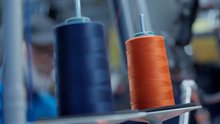Video circular textile
The impact of the textile sector is great. Every year we buy more and more clothes. The Ministry of Infrastructure and Water Management has a policy programme with goals to make the textile sector more sustainable.

Voice-over:
Your work suit. Your fancy dress. Your chill sweater.
We buy new clothes for every occasion.
As a result, each person buys countless items of clothing every single year.
But the production, and transportation of textiles requires raw materials,
energy and water and generates a lot of waste.
This has a major negative impact on the climate and environment.
This has to change.
The government, together with partners in the textile chain,
takes measures to make the textile sector more sustainable.
The goal is for all textiles to be sustainable and circular by 2050.
What are we doing to realize this future? Some examples:
The legislation for extended producer responsibility makes the producer responsible for the product,
even after it has been discarded by the consumer.This encourages improved collection,
sorting, reuse and recycling of textiles.
We encourage consumers to buy less new clothing, to take good care of their clothes and make them last longer. And to buy more secondhand clothing instead of new or purchase clothing made from
sustainable or recycled materials.
And we encourage the collection of used clothing at collection points so it can be reused or recycled. Several initiatives such as the Denim Deal for jeans push brands to use more recycled materials in their clothing.
And we are advocates within the EU to strive towards a circular textile chain.
In various places in the Netherlands, people are already working hard towards a future with 100% sustainable and circular textiles.
Consumers, businesses and government, are moving forward together toward a circular textile economy by 2050.
Want to know what you can do?
Go to www.afvalcirculair.nl/textiel